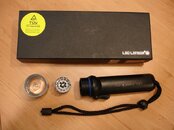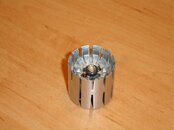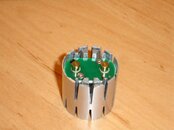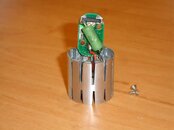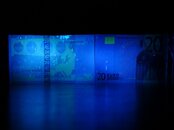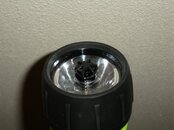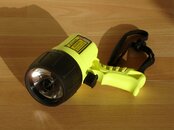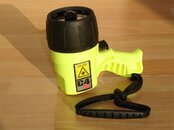A first night dive with
this lamp at the
Oostvoornse Meer was not very convincing, first of all because there was almost no life to see in the first place, second because the visibility was low, and third I suspect that the wavelength (around 400 nm, i.e., still pretty much in the range of visible light) and power of the UV LED was suboptimal.
I therefore modified a second diving lamp, the "Underwater Kinetics UK Sunlight C4 eLED" (for about 120 Euros), with the best UV LEDs available on the market (with a wavelength of 365 nm), two Nichia LEDs of type NCSU033B (see also
UV-LED/Nichia Corporation) ordered directly from Japan, for about 82 Euros per piece (plus customs VAT of 31 Euros).
The results are indeed much better than with my first attempt; when testing e.g. with some Euro bills, much more features become visible than with the first lamp. The range of the lamp is also much greater (tested at night with a fluorescing target at the end of my garden).
Modifying the "UK C4 eLED" diving lamp is straightforward: remove the white LEDs, and glue the new UV LEDs to the same place (e.g. with Arctic Silver Thermal Adhesive).
The electronic circuitry in the lamp provides a current source which can be configured to several different values (e.g. 0.7 A, 1.0 A, 1.3 A).
I left it in the "1.0 A" configuration it originally came with.
Although using the UV LEDs in parallel is not recommended in their specifications, the electronic circuit in the lamp left me no other choice (unless by modifying/duplicating the circuit, for which there is not much space in the lamp). Fortunately, both UV LEDs had very narrow tolerances, while one drew about 0.5 A, the other took about 0.52 A, which is still well within the specified limits.
Should you have any questions, I'd be glad to answer them.




